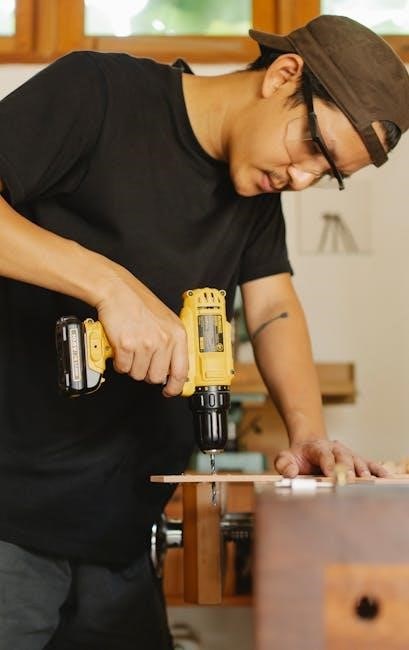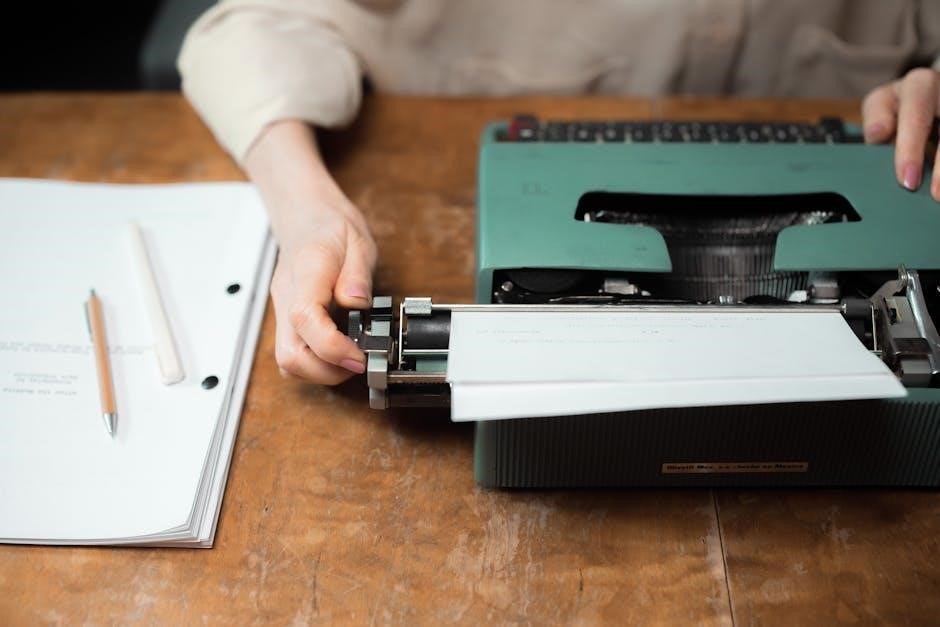A TENS machine is a non-invasive, battery-powered device that delivers electrical impulses to relieve pain. It has a long history, offering benefits like portability and ease of use. Always read the manual and consult a professional before use to ensure safety and effectiveness.
1.1 What is a TENS Machine?
A TENS (Transcutaneous Electrical Nerve Stimulation) machine is a battery-powered medical device that delivers low-voltage electrical impulses through electrodes placed on the skin. It is a non-invasive pain relief solution commonly prescribed for muscle aches, arthritis, and chronic pain. Professionals like physiotherapists often recommend it for its portability and effectiveness in managing discomfort.
1.2 Brief History and Development
The TENS machine originated from earlier electrotherapy devices, evolving in the 1960s and 1970s into a portable, user-friendly pain relief solution. Initially used in medical settings, advancements made it accessible for home use, offering customizable settings for personalized therapy. Over decades, TENS technology has been refined to enhance safety, effectiveness, and ease of use, becoming a popular choice for managing pain.
1.3 Purpose and Benefits
The primary purpose of a TENS machine is to provide temporary pain relief by delivering electrical impulses through electrodes placed on the skin. Benefits include non-invasive, portable, and customizable treatment options. It is effective for muscle soreness, chronic pain, and acute discomfort, offering users an alternative to medication. TENS units are also safe for long-term use when operated correctly.

Safety Guidelines and Precautions
Adhering to safety guidelines is crucial when using a TENS machine. Avoid use in water, while sleeping, or during activities requiring concentration. Follow manual instructions carefully.
2.1 Contraindications for Use
- Avoid using a TENS machine if you have a pacemaker or other implanted medical devices.
- Do not use during pregnancy, epilepsy, or on broken skin.
- Children and individuals with certain medical conditions should consult a doctor before use.
- Never place electrodes over the eyes, mouth, or prohibited areas as specified in the manual.
2.2 Safety Precautions for Operation
Always use the TENS machine as directed in the manual. Avoid operating it near water, while sleeping, or during activities requiring concentration. Ensure electrodes are placed on clean, dry skin, avoiding sensitive areas like the eyes or mouth. Start with low intensity and gradually increase for comfort. Turn off the device when not in use.
2.3 Warnings and Cautions
Always follow the manual’s warnings to prevent injury. Avoid using the TENS machine in water, near sensitive areas, or while driving. Do not use it on broken skin or if you have a pacemaker. Discontinue use if you experience discomfort or skin irritation. Consult a professional if you have epilepsy or other medical conditions.

Understanding the TENS Machine
A TENS machine includes a control unit, electrodes, and cables, delivering electrical impulses for pain relief. It offers adjustable intensity and modes for personalized therapy, with clear charging instructions provided.
3.1 Components of the TENS Unit
A TENS unit consists of a control unit, electrodes, lead wires, and a power source. The control unit houses the electronics, while electrodes are pads placed on the skin. Lead wires connect the control unit to the electrodes, enabling electrical impulse delivery. Additional components may include intensity controls, a battery compartment, and a user manual for operation guidance.
3.2 Controls and Functions
The TENS unit features controls for adjusting intensity, mode selection, and treatment duration. Most models include buttons to increase or decrease intensity, cycle through modes like Continuous or Pulse, and set timers. The device may also have a display showing current settings. Always refer to the manual for specific control functions and operation guidance.
3.3 Battery and Charging Instructions
Most TENS units are battery-powered, requiring alkaline or rechargeable batteries. Ensure the device is turned off before inserting batteries. Follow the manual’s charging instructions for rechargeable models. Avoid using the device while charging. Replace batteries when low to maintain performance. Always store spare batteries correctly to prevent leakage or damage. Refer to the manual for specific battery care guidelines.

Operating the TENS Machine
Turn the device on, adjust intensity levels, and select modes as needed. Start with low settings and gradually increase for comfort. Begin treatment promptly after setup.
4.1 Step-by-Step Guide to Using the Device
- Ensure the TENS machine is turned off before attaching electrodes.
- Insert batteries or charge the unit as per instructions.
- Apply electrodes to clean, dry skin in the target pain area.
- Turn the device on and select the desired mode.
- Adjust intensity levels starting low, then increase as needed.
- Begin treatment and monitor comfort levels throughout.
4.2 Setting the Intensity and Modes
Start with the lowest intensity setting and gradually increase until the sensation is comfortable. Choose from modes like Burst, Pulse, or Modulated for varying stimulation patterns. Adjust intensity using the control buttons to achieve optimal pain relief without discomfort. Ensure settings align with your specific pain type for maximum effectiveness.
4.3 Adjusting Treatment Time
Turn the device off, set the timer using the control buttons, and press the button to finalize the duration. Treatment time typically ranges from 20 to 60 minutes. Always follow the manual’s guidelines for your specific condition. Ensure the device is not used during activities like driving or operating machinery for safety reasons.

Electrode Placement and Care
Place electrodes on clean, dry skin, avoiding bony areas. Use electrode gel pads for better adhesion and comfort. Ensure proper placement for effective pain relief and skin protection.
5.1 Proper Placement Techniques
Place electrodes on clean, dry skin, avoiding bony areas. Use electrode gel pads for better adhesion and comfort. Position them around the pain area, not overlapping. Ensure proper contact for effective stimulation and to prevent skin irritation. Follow the manual’s guidelines to achieve optimal pain relief and avoid discomfort.
5.2 Skin Preparation for Electrodes
Ensure skin is clean, dry, and free from oils or lotions for optimal electrode adhesion. Remove hair if necessary for better contact. Avoid placing electrodes over broken or irritated skin. Use electrode gel pads to enhance conductivity and comfort. Proper skin preparation ensures effective treatment and prevents discomfort or skin irritation during use.
5.3 Maintenance and Reuse of Electrodes
Clean electrodes with mild soap and water after use. Allow them to air dry before storage. Replace the gel pads periodically to maintain adhesion. Store electrodes in a protective case to prevent damage. Avoid using harsh chemicals, as they may degrade the material. Reuse electrodes only if they retain their adhesive properties and are free from dirt or damage.

Common Applications and Indications
TENS machines provide temporary relief for muscle soreness, targeting areas like the back, shoulder, and waist. They are effective for both chronic and acute pain, and can be used alongside other therapies.
6;1 Pain Relief for Specific Body Areas
TENS machines are commonly used to relieve pain in specific body areas such as the back, shoulder, and waist. They effectively target sore muscles and provide comfort by delivering electrical impulses through electrodes placed on or around the painful region, avoiding bony prominences for optimal results.
6.2 Use for Chronic vs. Acute Pain
TENS machines are effective for both chronic and acute pain management, offering temporary relief for muscle soreness. Chronic pain benefit from long-term use, while acute pain responds well to short-term applications. Always consult a professional to tailor treatment plans for specific pain types and ensure safe, effective use.
6.3 Combining TENS with Other Therapies
TENS machines can be used alongside other therapies, such as physical therapy or heat therapy, to enhance pain relief. This combination allows for a more comprehensive approach to managing pain. Always consult a professional to ensure the combined treatment is safe and effective for your specific condition.

Troubleshooting and Maintenance
Common issues include low battery, loose connections, or improper electrode placement. Check the device and wires for damage and ensure electrodes are clean.
Regularly clean the device and store it in a dry place. Replace worn-out parts and refer to the manual for maintenance guidelines.
7.1 Common Issues and Solutions
Common issues with TENS machines include low battery, loose electrode connections, or improper placement. Solutions involve checking the power source, ensuring secure electrode attachment, and consulting the manual for troubleshooting. Clean the device regularly and replace damaged parts to maintain functionality. Always refer to the manual for specific solutions to ensure optimal performance and safety.
7.2 Cleaning and Storing the Device
Clean the TENS machine with a soft, damp cloth, avoiding harsh chemicals or submerging it in water. Store the device in a cool, dry place, away from direct sunlight. Regularly inspect and clean electrodes to maintain conductivity. Proper storage ensures longevity and prevents damage, keeping the device ready for safe and effective use.
7.3 Replacement of Parts and Accessories
Replace electrodes, lead wires, or batteries as needed. Always consult the user manual for compatibility. Avoid using damaged parts, as they may compromise safety or performance. Order replacements from authorized suppliers to ensure quality. Regularly check for worn-out components and replace them promptly to maintain optimal functionality and longevity of the TENS device.

8.Consulting a Professional
Consulting a Professional
Consult a healthcare professional before using a TENS machine, especially if you’re a first-time user. Physiotherapists can guide proper usage and customize treatment plans for optimal pain relief.
8.1 When to Seek Medical Advice
Consult a healthcare professional before using a TENS machine, especially if you’re a first-time user or have underlying medical conditions like epilepsy or heart issues. Seek advice if you experience skin irritation, dizziness, or unusual sensations. Medical guidance ensures safe and effective use of the device for pain relief.
8.2 Role of Physiotherapists in TENS Therapy
Physiotherapists play a crucial role in TENS therapy by providing expert guidance on electrode placement and treatment settings. They help customize therapy plans based on individual needs, ensuring safe and effective pain relief. Their expertise minimizes risks and maximizes benefits, making them essential consultants for optimizing TENS machine use.
8.3 Customizing Treatment Plans
Customizing treatment plans ensures personalized pain relief. Physiotherapists assess individual needs to adjust intensity, mode, and duration. They monitor progress and adapt settings for optimal results. Regular follow-ups and adjustments ensure the therapy remains effective, providing tailored relief and improving overall well-being.

User Manual and Additional Resources
The user manual provides essential instructions for operating the TENS machine safely and effectively. Digital copies are available for download, ensuring easy access to guidelines and troubleshooting tips. Online support and FAQs offer additional assistance for users seeking clarification or further information.
9.1 Importance of Reading the Manual
Reading the manual is crucial for understanding safety guidelines, contraindications, and proper usage of the TENS machine. It ensures effective pain relief while minimizing risks of injury or device malfunction. Always follow the instructions to optimize treatment outcomes and maintain user safety.
9.2 Accessing Digital Copies of Manuals
Digital copies of TENS machine manuals are readily available in English and French. Users can download PDF versions from official websites or authorized distributors. This ensures easy access to safety guidelines, usage instructions, and troubleshooting tips. Digital manuals are convenient for quick reference and eliminate the risk of losing a physical copy.
9.3 Online Support and FAQs
Official TENS machine websites offer online support, including detailed FAQs, troubleshooting guides, and contact options for assistance. FAQs address common queries about device setup, electrode placement, and error resolution. Users can access 24/7 support through email or live chat, ensuring quick solutions to any issues without delay.
